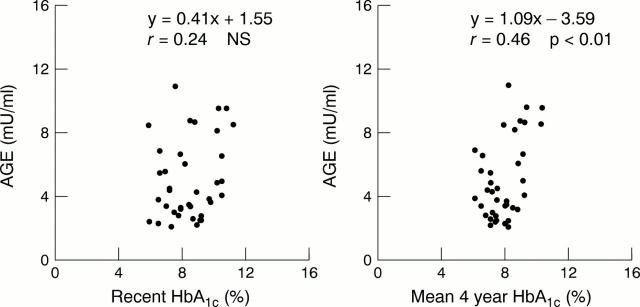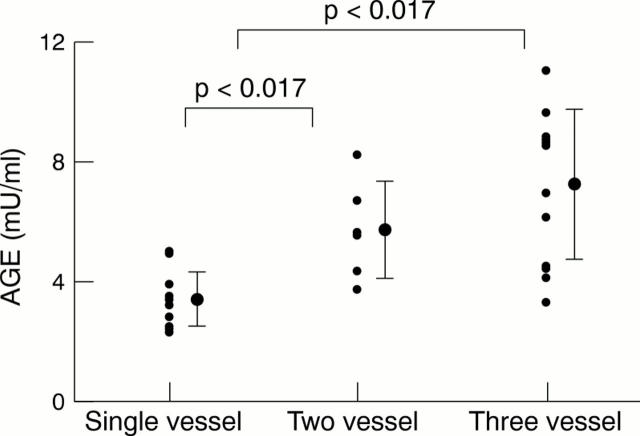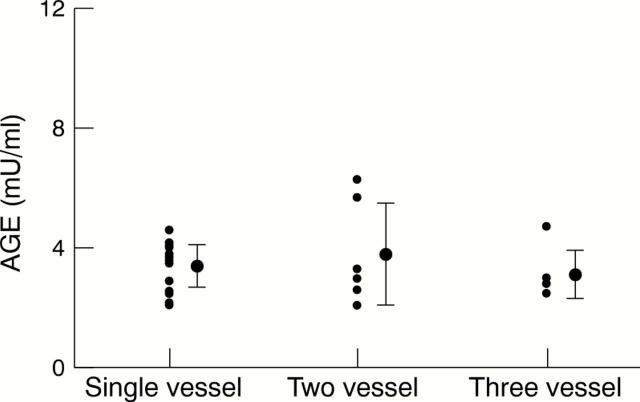Abstract
OBJECTIVE—To assess whether the concentrations of serum advanced glycation end products (AGE) in diabetic patients with obstructive coronary artery disease differ from those in type 2 diabetic patients without obstructive coronary artery disease. DESIGN—Serum AGE concentrations were measured in type 2 diabetic patients and in non-diabetic patients, both with and without obstructive coronary artery disease, and the relation between these values and coronary disease severity was evaluated. RESULTS—Mean (SD) serum AGE concentrations were higher (p < 0.0125) in type 2 diabetic patients with obstructive coronary artery disease (5.5 (2.5) mU/ml, n = 30) than in patients without obstructive coronary artery disease (2.8 (0.5) mU/ml, n = 12), and higher than in non-diabetic patients with (3.4 (1.0) mU/ml, n = 28) and without (3.2 (0.4) mU/ml, n = 13) obstructive coronary artery disease. Serum AGE was associated with the degree of coronary arteriosclerosis in type 2 diabetic patients with obstructive coronary artery disease (single vessel: n = 13, 3.4 (0.9) mU/m; two vessel: n = 6, 5.7 (1.6) mU/m; three vessel: n = 11, 7.2 (2.5) mU/ml). Serum AGE was positively correlated with serum mean four year HbA1C (r = 0.46, p < 0.01), but not with recent serum HbA1C (r = 0.24). The four groups did not differ in the other coronary risk factors. CONCLUSIONS—Serum AGE concentrations may be associated with long term poor glycaemic control and reflect the severity of coronary arteriosclerosis in type 2 diabetic patients. Keywords: advanced glycation end products; non-insulin dependent diabetes; coronary artery disease
Full Text
The Full Text of this article is available as a PDF (156.5 KB).
Figure 1 .
Scatterplot showing relation between AGE and recent HbA1C (left), and mean four year HbA1C (right). Recent HbA1C was not correlated with serum AGE, whereas there was a significant but weak correlation between mean four year HbA1C and serum AGE (r = 0.46, p < 0.01).
Figure 2 .
Serum AGE concentrations and the severity of coronary arteriosclerosis in the diabetic patients with obstructive coronary artery disease. Serum AGE increased with the severity of coronary arteriosclerosis in the diabetic patients with obstructive coronary artery disease.
Figure 3 .
Serum AGE concentrations and the severity of coronary arteriosclerosis in the non-diabetic patients with obstructive coronary artery disease. Serum AGE did not increase in these patients and did not correlate with the severity of the coronary arteriosclerosis.
Selected References
These references are in PubMed. This may not be the complete list of references from this article.
- Berg T. J., Bangstad H. J., Torjesen P. A., Osterby R., Bucala R., Hanssen K. F. Advanced glycation end products in serum predict changes in the kidney morphology of patients with insulin-dependent diabetes mellitus. Metabolism. 1997 Jun;46(6):661–665. doi: 10.1016/s0026-0495(97)90010-x. [DOI] [PubMed] [Google Scholar]
- Bierhaus A., Chevion S., Chevion M., Hofmann M., Quehenberger P., Illmer T., Luther T., Berentshtein E., Tritschler H., Müller M. Advanced glycation end product-induced activation of NF-kappaB is suppressed by alpha-lipoic acid in cultured endothelial cells. Diabetes. 1997 Sep;46(9):1481–1490. doi: 10.2337/diab.46.9.1481. [DOI] [PubMed] [Google Scholar]
- Brownlee M., Cerami A., Vlassara H. Advanced glycosylation end products in tissue and the biochemical basis of diabetic complications. N Engl J Med. 1988 May 19;318(20):1315–1321. doi: 10.1056/NEJM198805193182007. [DOI] [PubMed] [Google Scholar]
- Bucala R., Makita Z., Koschinsky T., Cerami A., Vlassara H. Lipid advanced glycosylation: pathway for lipid oxidation in vivo. Proc Natl Acad Sci U S A. 1993 Jul 15;90(14):6434–6438. doi: 10.1073/pnas.90.14.6434. [DOI] [PMC free article] [PubMed] [Google Scholar]
- Bucala R., Tracey K. J., Cerami A. Advanced glycosylation products quench nitric oxide and mediate defective endothelium-dependent vasodilatation in experimental diabetes. J Clin Invest. 1991 Feb;87(2):432–438. doi: 10.1172/JCI115014. [DOI] [PMC free article] [PubMed] [Google Scholar]
- Fletcher M. J. A colorimetric method for estimating serum triglycerides. Clin Chim Acta. 1968 Nov;22(3):393–397. doi: 10.1016/0009-8981(68)90041-7. [DOI] [PubMed] [Google Scholar]
- Friedewald W. T., Levy R. I., Fredrickson D. S. Estimation of the concentration of low-density lipoprotein cholesterol in plasma, without use of the preparative ultracentrifuge. Clin Chem. 1972 Jun;18(6):499–502. [PubMed] [Google Scholar]
- Gidez L. I., Miller G. J., Burstein M., Slagle S., Eder H. A. Separation and quantitation of subclasses of human plasma high density lipoproteins by a simple precipitation procedure. J Lipid Res. 1982 Nov;23(8):1206–1223. [PubMed] [Google Scholar]
- Hasegawa G., Nakano K., Sawada M., Uno K., Shibayama Y., Ienaga K., Kondo M. Possible role of tumor necrosis factor and interleukin-1 in the development of diabetic nephropathy. Kidney Int. 1991 Dec;40(6):1007–1012. doi: 10.1038/ki.1991.308. [DOI] [PubMed] [Google Scholar]
- Kilhovd B. K., Berg T. J., Birkeland K. I., Thorsby P., Hanssen K. F. Serum levels of advanced glycation end products are increased in patients with type 2 diabetes and coronary heart disease. Diabetes Care. 1999 Sep;22(9):1543–1548. doi: 10.2337/diacare.22.9.1543. [DOI] [PubMed] [Google Scholar]
- Kirstein M., Brett J., Radoff S., Ogawa S., Stern D., Vlassara H. Advanced protein glycosylation induces transendothelial human monocyte chemotaxis and secretion of platelet-derived growth factor: role in vascular disease of diabetes and aging. Proc Natl Acad Sci U S A. 1990 Nov;87(22):9010–9014. doi: 10.1073/pnas.87.22.9010. [DOI] [PMC free article] [PubMed] [Google Scholar]
- Makita Z., Radoff S., Rayfield E. J., Yang Z., Skolnik E., Delaney V., Friedman E. A., Cerami A., Vlassara H. Advanced glycosylation end products in patients with diabetic nephropathy. N Engl J Med. 1991 Sep 19;325(12):836–842. doi: 10.1056/NEJM199109193251202. [DOI] [PubMed] [Google Scholar]
- Makita Z., Vlassara H., Cerami A., Bucala R. Immunochemical detection of advanced glycosylation end products in vivo. J Biol Chem. 1992 Mar 15;267(8):5133–5138. [PubMed] [Google Scholar]
- Nakayama H., Taneda S., Kuwajima S., Aoki S., Kuroda Y., Misawa K., Nakagawa S. Production and characterization of antibodies to advanced glycation products on proteins. Biochem Biophys Res Commun. 1989 Jul 31;162(2):740–745. doi: 10.1016/0006-291x(89)92372-3. [DOI] [PubMed] [Google Scholar]
- Ono Y., Aoki S., Ohnishi K., Yasuda T., Kawano K., Tsukada Y. Increased serum levels of advanced glycation end products in NIDDM patients with diabetic complications. Diabetes Care. 1998 Jun;21(6):1027–1027. [PubMed] [Google Scholar]
- Renard C., Chappey O., Wautier M. P., Nagashima M., Lundh E., Morser J., Zhao L., Schmidt A. M., Scherrmann J. M., Wautier J. L. Recombinant advanced glycation end product receptor pharmacokinetics in normal and diabetic rats. Mol Pharmacol. 1997 Jul;52(1):54–62. doi: 10.1124/mol.52.1.54. [DOI] [PubMed] [Google Scholar]
- Richmond W. Preparation and properties of a cholesterol oxidase from Nocardia sp. and its application to the enzymatic assay of total cholesterol in serum. Clin Chem. 1973 Dec;19(12):1350–1356. [PubMed] [Google Scholar]
- Sun M., Yokoyama M., Ishiwata T., Asano G. Deposition of advanced glycation end products (AGE) and expression of the receptor for AGE in cardiovascular tissue of the diabetic rat. Int J Exp Pathol. 1998 Aug;79(4):207–222. [PMC free article] [PubMed] [Google Scholar]





